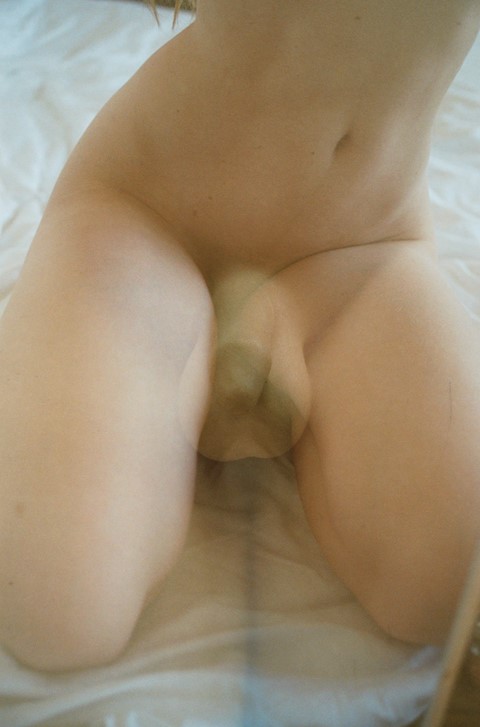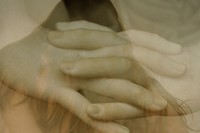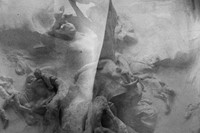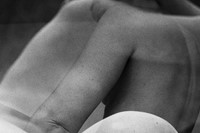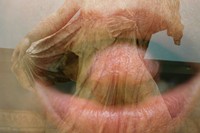The photographer takes us through her latest publication, Touching: a dreamy, diaristic study of the physical form
Great photographs inevitably involve an element of serendipity; of talent and hard work combining with aesthetic luck to create moments of magic. “I pray for what might be referred to as the angel of chance,” Sally Mann wrote of her creative process. For her latest series, Touching, photographer Lina Scheynius handed the reins over to that angel of chance, making fate a determining element of her method. “I honestly look at these images and I know that technically I am the one who made them,” she tells AnOther, “but they also feel sort of otherworldly to me and that I can’t take full ownership of them.”
After over a decade of enthralling us with her dreamy, diaristic style of image-making, Touching marks a departure for Scheynius, who makes the move into double exposures with a series of images that juxtapose ancient sculptures and her own body.
Over the course of a couple of years, Scheynius shot an assortment of different sculptures, not keeping track of who created them or where she found them, just letting herself be guided by impulse and gut instinct. She then put the exposed rolls back in her camera and shot them again against her body at home. After testing the method out a few times, Scheynius recognised the poetic potential of the project. “I was blown away by a couple of the images and had to dig further,” she says.
The result is a series of captivating, visceral photographs; a palimpsest of bodies where flesh, both stone and human, unrelated except by chance and circumstance, become interwoven, competing with and infiltrating each other. Tongues graze feet, hands grab hips, wings protrude from shoulders. Some of the photographs align so perfectly, creating images so beautiful, it’s astonishing to think they were an accident.
“I am not completely unfamiliar with giving up control as I always shoot with film, and I have shot self portraits with a tripod for many years, so I know the feeling of not knowing what the image will look like when the shutter goes off,” Scheynius says. “But this is so much more of an accident than that. In the end I facilitated them happening, but chance played such a big part in it too.”
Alongside the images, Touching features, for the first time, narrative about the photographs from Scheynius, who in the past has been steadfast in refusing explanation about the meaning or message of her work. Weaved throughout the book, the dreamy vignettes both extend and illuminate the images, offering details about the process alongside deeper reflection about the nature of the work. “I can’t say why now felt like the right time when I have been so hesitant in the past. And I can’t say it was an easy process either,” she says. “But ultimately I think it adds another layer to the images and opens a window for the viewer without taking away the magic.”

One of the questions Scheynius explores in the narrative concerns self-portraiture, which over the years has been a central part of her oeuvre. Writing that she doesn’t always like doing it nor does she always like what she sees, particularly as she gets older, Scheynius grapples with why she has taken all of these photographs of herself and who has she done it for. “Is it healing or the opposite or neither,” she asks.
“I get a certain kick out of doing it, almost a high sometimes. It’s like dancing,” she offers on why she feels compelled to keep taking self-portraits despite the conflicting emotions. “Sharing and creating are very different things though, and why I feel the need to keep sharing I am not sure of, and sometimes I waver here.” But ultimately, she says, the feedback she receives from people confirms the importance of sharing vulnerability.
Where she shares this vulnerability, however, has shifted over the years. Having started out her photography career on sites like Tumblr and Flickr – where her work swiftly attracted a large fan base – she has recently grown disillusioned with social media. She finds Instagram’s commercialisation and censorship of art, as well as its failure to protect artists, particularly troubling. It’s one of the reasons she turned her gaze back centuries and found herself drawn to classical art and ancient sculpture.
“For me personally, I have hit a sort of wall with social media and I’m trying to rethink how and why I use it,” she says. “I do feel in my community that there is a strong urge to find an alternative. I recently started a substack account where I share unseen work with a small audience and that feels really right for me at the moment.”
Touching by Lina Scheynius will be published by JBE Books in January 2022.
